Transcriptomic changes induced by mycophenolic acid in gastric cancer cells
- PMID: 24349619
- PMCID: PMC3853422
Transcriptomic changes induced by mycophenolic acid in gastric cancer cells
Abstract
Background: Inhibition of inosine monophosphate dehydrogenase (IMPDH) by mycophenolic acid (MPA) can inhibit proliferation and induce apoptosis in cancer cells. This study investigated the underlying molecular mechanisms of MPA's anticancer activity.
Methods: A gastric cancer cell line (AGS) was treated with MPA and gene expression at different time points was analyzed using Illumina whole genome microarrays and selected genes were confirmed by real-time RT-PCR.
Results: Transcriptomic profiling identified 1070 genes with ≥2 fold changes and 85 genes with >4 fold alterations. The most significantly altered biological processes by MPA treatment include cell cycle, apoptosis, cell proliferation and migration. MPA treatment altered at least ten KEGG pathways, of which eight (p53 signaling, cell cycle, pathways in cancer, PPAR signaling, bladder cancer, protein processing in ER, small cell lung cancer and MAPK signaling) are cancer-related. Among the earliest cellular events induced by MPA is cell cycle arrest which may be caused by six molecular pathways: 1) up-regulation of cyclins (CCND1 and CCNE2) and down-regulation of CCNA2 and CCNB1, 2) down-regulation of cyclin-dependent kinases (CDK4 and CDK5); 3) inhibition of cell division related genes (CDC20, CDC25B and CDC25C) and other cell cycle related genes (MCM2, CENPE and PSRC1), 4) activation of p53, which activates the cyclin-dependent kinase inhibitors (CDKN1A), 5) impaired spindle checkpoint function and chromosome segregation (BUB1, BUB1B, BOP1, AURKA, AURKB, and FOXM1); and 6) reduction of availability of deoxyribonucleotides and therefore DNA synthesis through down-regulation of the RRM1 enzyme. Cell cycle arrest is followed by inhibition of cell proliferation, which is mainly attributable to the inhibition of the PI3K/AKT/mTOR pathway, and caspase-dependent apoptosis due to up-regulation of the p53 and FAS pathways.
Conclusions: These results suggest that MPA has beneficial anticancer activity through diverse molecular pathways and biological processes.
Keywords: MPA; drug repurposing; microarray; regulatory networks.
Figures
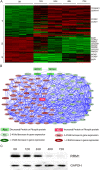
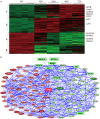
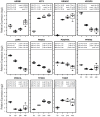
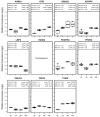
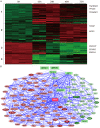
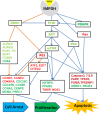
Similar articles
-
Delineation of biological and molecular mechanisms underlying the diverse anticancer activities of mycophenolic acid.Int J Clin Exp Pathol. 2013 Nov 15;6(12):2880-6. eCollection 2013. Int J Clin Exp Pathol. 2013. PMID: 24294374 Free PMC article.
-
Mycophenolic acid inhibits migration and invasion of gastric cancer cells via multiple molecular pathways.PLoS One. 2013 Nov 15;8(11):e81702. doi: 10.1371/journal.pone.0081702. eCollection 2013. PLoS One. 2013. PMID: 24260584 Free PMC article.
-
Inhibition of mitotic Aurora kinase A by alisertib induces apoptosis and autophagy of human gastric cancer AGS and NCI-N78 cells.Drug Des Devel Ther. 2015 Jan 14;9:487-508. doi: 10.2147/DDDT.S74127. eCollection 2015. Drug Des Devel Ther. 2015. PMID: 25609923 Free PMC article.
-
[Molecular mechanisms controlling the cell cycle: fundamental aspects and implications for oncology].Cancer Radiother. 2001 Apr;5(2):109-29. doi: 10.1016/s1278-3218(01)00087-7. Cancer Radiother. 2001. PMID: 11355576 Review. French.
-
Monitoring of inosine monophosphate dehydrogenase activity as a biomarker for mycophenolic acid effect: potential clinical implications.Ther Drug Monit. 2007 Apr;29(2):141-9. doi: 10.1097/FTD.0b013e31803d37b6. Ther Drug Monit. 2007. PMID: 17417067 Review.
Cited by
-
Analysis of cyclin E co-expression genes reveals nuclear transcription factor Y subunit alpha is an oncogene in gastric cancer.Chronic Dis Transl Med. 2018 Oct 23;5(1):44-52. doi: 10.1016/j.cdtm.2018.07.003. eCollection 2019 Mar. Chronic Dis Transl Med. 2018. PMID: 30993263 Free PMC article.
-
Tumor profiling of co-regulated receptor tyrosine kinase and chemoresistant genes reveal different targeting options for lung and gastroesophageal cancers.Am J Transl Res. 2016 Dec 15;8(12):5729-5740. eCollection 2016. Am J Transl Res. 2016. PMID: 28078044 Free PMC article.
-
Connectivity mapping using a combined gene signature from multiple colorectal cancer datasets identified candidate drugs including existing chemotherapies.BMC Syst Biol. 2015;9 Suppl 5(Suppl 5):S4. doi: 10.1186/1752-0509-9-S5-S4. Epub 2015 Sep 1. BMC Syst Biol. 2015. PMID: 26356760 Free PMC article.
-
Integration of "omics" techniques: Dronedarone affects cardiac remodeling in the infarction border zone.Exp Biol Med (Maywood). 2018 Jul;243(11):895-910. doi: 10.1177/1535370218788517. Exp Biol Med (Maywood). 2018. PMID: 30105952 Free PMC article.
-
Mycophenolic acid treatment drives the emergence of novel SARS-CoV-2 variants.Proc Natl Acad Sci U S A. 2025 Jul 15;122(28):e2500276122. doi: 10.1073/pnas.2500276122. Epub 2025 Jul 9. Proc Natl Acad Sci U S A. 2025. PMID: 40632557 Free PMC article.
References
-
- Morath C, Schwenger V, Beimler J, Mehrabi A, Schmidt J, Zeier M, Muranyi W. Antifibrotic actions of mycophenolic acid. Clin Transplant. 2006;20(Suppl 17):25–29. - PubMed
-
- Allison AC, Eugui EM. Mycophenolate mofetil and its mechanisms of action. Immunopharmacology. 2000;47:85–118. - PubMed
-
- Jackson RC, Weber G, Morris HP. IMP dehydrogenase, an enzyme linked with proliferation and malignancy. Nature. 1975;256:331–333. - PubMed
-
- Fellenberg J, Bernd L, Delling G, Witte D, Zahlten-Hinguranage A. Prognostic significance of drug-regulated genes in high-grade osteosarcoma. Mod Pathol. 2007;20:1085–1094. - PubMed
LinkOut - more resources
Full Text Sources
Other Literature Sources
Molecular Biology Databases
Research Materials
Miscellaneous
